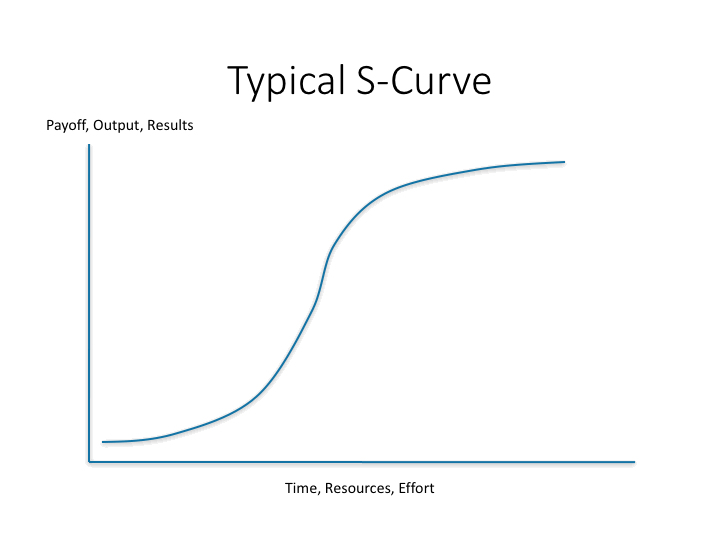
I recall one of the best advice I received as a Product Owner when trying to determine what we should build next for our product that was trying to compete in a ferocious market. I invited my mentor to our brainstorming session I was facilitating in order to get ideas from our GTM (Go To Market) Team. He asked me the purpose of the meeting, glared at me, and said
- "Lance, all of the answers to what you should build next are outside of this building".
As we reach the middle of our listing for the Top 10 Challenges of Product Delivery; this one to me is really important. Not only are we facing the changing landscape in the products we build, but also the skills required to manage the products.
It can be a bit daunting to think of the playing field out there today and how hyper-competitive it really is in relation to just a quarter century ago. We know that technology products and innovation grow on a classic "S-curve", but how far up are we on that curve right now?

It is amazing to see how many options people generally have for the regular products they use day in and day out. If they get upset about how they are treated or the product is handling their data, they simply can leave that product and jump to a new one. The game used to be "how many hooks can we keep in a customer to make them stay?".
Now those hooks can be the very reason a customer leaves your product. It is critical that product managers and their leadership understand the landscape of the changing market conditions that are present and different today. Failing to adapt to changes in the market can have significant repercussions, potentially leading to its decline and obsolescence.
In the dynamic landscape of modern business, where consumer preferences evolve rapidly, technology advances continuously, and competitive landscapes shift, the inability to pivot or adjust a product strategy can be detrimental.
Outcomes of Not Adapting
Loss of Market Share
When a product does not evolve in response to changing market demands or emerging trends, it risks becoming irrelevant to its target audience. Competitors that are more agile and responsive to these changes can quickly capitalize on the opportunity, offering alternatives that better meet customer needs. This can result in a significant loss of market share as customers migrate to competitors' products that offer more value, innovation, or alignment with their expectations.
Diminished Brand Reputation
Brand reputation is closely tied to a company's ability to innovate and meet market demands. Failing to adapt can tarnish a brand's image, casting it as outdated or out of touch with its customer base. This perception can be hard to reverse and may deter potential customers from considering the product, even if future updates attempt to address past shortcomings. The long-term impact on brand reputation can hinder not only the product in question but also other products and services offered by the company.
Reduced Revenue and Profitability
As market share declines and brand reputation suffers, the financial performance of the product is likely to follow suit. Reduced sales will directly impact revenue, and the costs associated with attempting to revitalize an outdated product can further erode profitability. Moreover, the resources spent on trying to catch up or make last-minute adjustments to the product could have been more effectively used in proactive innovation and development efforts.
Missed Opportunities for Growth and Innovation
By not adapting to market changes, companies miss out on opportunities to explore new markets, technologies, and business models. This stagnation not only affects the current product lifecycle but also limits the organization's potential for future growth and innovation. Competitors that are more attuned to market dynamics will be better positioned to capture emerging opportunities, further consolidating their market position and potentially disrupting the industry.
Increased Risk of Product Obsolescence
Ultimately, the most severe consequence of failing to adapt is the risk of product obsolescence. As the gap between customer expectations and the product's value proposition widens, the product may become completely irrelevant, leading to its withdrawal from the market. This not only represents a failure of the product but also a significant waste of resources and a missed opportunity for the company to evolve and thrive.
Practical Techniques to Employ
Adapting to market changes represents a significant challenge for product managers in today's rapidly evolving business landscape. The ability to pivot and respond to new trends, customer behaviors, technological advancements, and competitive dynamics is critical for sustaining growth and maintaining relevance.
Market changes can manifest in various forms, including shifts in consumer preferences, emerging technologies, regulatory changes, and new competitors entering the space. These dynamics necessitate a flexible and forward-thinking approach to product management.
Let's explore some common practical techniques product managers can employ to minimize the challenges associated with adapting to market changes.
Continuous Market Research and Customer Feedback
Staying informed about market trends and customer preferences is foundational to effective product management. Product managers should establish mechanisms for ongoing market research and customer feedback collection, such as:
- Surveys and Interviews: Regularly conducting surveys and interviews with current and potential customers to gain insights into their needs, preferences, and pain points.
- Market Analysis: Keeping abreast of industry reports, competitor activities, and market analysis to identify emerging trends and opportunities.
- Feedback Loops: Implementing continuous feedback loops through social media, customer support interactions, and product analytics to gather real-time insights.
Agile Product Development
We figured putting this at the top would be a dead give-away that we were trying to advertise that we can help with this one (LOL). Embracing agile methodologies allows product teams to be more adaptable and responsive to market changes. Agile practices support iterative development, enabling rapid prototyping, testing, and refinement based on user feedback and changing market conditions. Key aspects include:
- Flexible Roadmaps: Developing product roadmaps that outline a general direction while allowing for adjustments as new information emerges.
- Cross-functional Teams: Fostering collaboration among cross-functional teams to accelerate decision-making and implementation of changes.
- Iterative Releases: Launching products in stages or as minimum viable products (MVPs) to test market reactions and refine the offering based on feedback.
Leveraging Data and Analytics
Data-driven decision-making is crucial for navigating market changes effectively. Product managers should leverage data analytics to:
- Monitor Key Metrics: Track key performance indicators (KPIs) related to user engagement, market share, and customer satisfaction to identify shifts in market dynamics.
- Predictive Analytics: Use predictive analytics to forecast trends and model potential market scenarios, guiding strategic decisions.
- A/B Testing: Conduct A/B testing on features, pricing, and marketing messages to determine what resonates best with the target audience.
Strategic Partnerships and Collaboration
Forming strategic partnerships can provide valuable insights and flexibility to respond to market changes. Partnerships can:
- Extend Capabilities: Collaborate with other companies to extend product capabilities, reach new markets, or leverage emerging technologies.
- Gain Market Insights: Work with research firms, industry consortia, and academic institutions to deepen understanding of market trends and technological advancements.
- Build Ecosystems: Participate in or build ecosystems around your product to create additional value for customers and stay ahead of market trends.
Cultivating a Culture of Innovation
Creating a culture that embraces change and innovation is essential for adapting to market shifts. Product managers can:
- Encourage Experimentation: Promote a culture where experimentation and learning from failures are valued as pathways to innovation.
- Empower Teams: Empower product teams to make decisions and take action based on their understanding of the market and customer needs.
- Continuous Learning: Invest in ongoing training and development to ensure the product team is equipped with the latest skills and knowledge relevant to the market.
Finally, I thought it best to explore some skills required whether you have been a product manager for some time or just getting in the game.
Market Research and Analysis
- Skill: Ability to conduct thorough market research and analyze data to understand market trends, customer needs, and competitive landscapes.
- Application: Enables product managers to identify emerging opportunities and threats, guiding strategic decision-making and product positioning.
Agile and Lean Concepts
- Skill: Proficiency in agile and lean practices, emphasizing flexibility, rapid iteration, and value-driven development.
- Application: Helps product managers to adapt quickly to market changes by facilitating faster product iterations and incorporating feedback continuously.
Strategic Thinking and Planning
- Skill: Capacity for strategic thinking and the ability to develop long-term plans with the flexibility to adjust as market conditions evolve.
- Application: Allows product managers to align product development with overarching business goals while remaining adaptable to unforeseen market shifts.
Customer Empathy and User Experience Focus
- Skill: Deep understanding of customer empathy and a strong focus on user experience.
- Application: Empowers product managers to create products that truly resonate with customers, ensuring that product adaptations are customer-centric and driven by user needs.
Communication and Stakeholder Management
- Skill: Exceptional communication and stakeholder management abilities, including negotiation, persuasion, and conflict resolution.
- Application: Crucial for advocating for product changes, aligning diverse stakeholder groups, and ensuring that adaptations are understood and supported across the organization.
Technological Proficiency
- Skill: Up-to-date knowledge of relevant technologies, digital tools, and platforms that can impact the product or market.
- Application: Positions product managers to leverage technological advancements for product innovation and to anticipate how tech trends may influence market dynamics.
Data-Driven Decision Making
- Skill: Ability to make informed decisions based on data analysis, metrics, and key performance indicators (KPIs).
- Application: Guides product managers in validating assumptions, measuring the impact of market changes, and making evidence-based decisions regarding product adaptations.
Risk Management and Contingency Planning
- Skill: Proficiency in identifying potential risks and developing effective contingency plans.
- Application: Equips product managers to anticipate challenges that could arise from market changes and to have strategies in place to mitigate these risks.
Adaptability and Resilience
- Skill: High levels of adaptability and resilience in the face of ambiguity and change.
- Application: Ensures that product managers can navigate setbacks and challenges without losing momentum, maintaining a positive and proactive approach to market adaptation.
Leadership and Team Collaboration
- Skill: Strong leadership and the ability to foster collaboration within cross-functional teams.
- Application: Vital for rallying teams around a shared vision for adaptation, fostering a culture of innovation, and executing strategic pivots effectively.
While we certainly didn't expect to elaborate on each one of these, we wanted to give a good list to start your own research and exploration into these skills. We can help with some of them even in our own workshops.
Closing
By cultivating these skills, product managers can enhance their ability to respond to and capitalize on market changes, ensuring that their products remain competitive and aligned with customer needs and market opportunities. Continuous learning and development in these areas are essential for product managers aiming to excel in a rapidly evolving market landscape.
We would love to see you in our upcoming workshops where we can explore many of these concepts we have just discussed and even more from our Top 10 List.